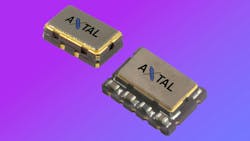TCXOs Meet Mission-Critical Needs of LEO Space Applications
This article is part of the TechXchanges: It's About Time and Defense Electronics.
The Overview
Q-Tech’s New Space Series of temperature-compensated crystal oscillators (TCXOs) are optimized for low-Earth-orbit (LEO) satellite timing and frequency-generation tasks. The devices offer low phase noise, high-frequency stability, and radiation hardness in two small package sizes.
Who Needs It & Why?
There are no second chances to get a LEO satellite designed correctly once it’s deployed. Thus, components intended for such applications require a high level of performance; optimization for size, weight, and power (SWaP); and extreme levels of radiation hardness. Q-Tech’s New Space Series of TCXOs, designed by the company’s German affiliate, AXTAL, fit the bill for these mission-critical applications in LEOs.
Under the Hood
Built with a modern TCXO IC, the devices exhibit low phase noise and high-frequency stability and are fully TID and SEE radiation tested. They're offered in two hermetically sealed, small-footprint, surface-mounted ceramic packages: AXLE5032S (5 × 3.2 mm) and AXLE7050S (7 × 5 mm). The TCXOs can be tested and screened to specific customer requirements; swept crystal versions are available.
Key features of the New Space Series are radiation tolerance to 50 kRad(Si) TID and single-event latch-up (SEL) immunity (tested up to 120 MeV-cm2/mg). They provide selectable frequency stability (±1 to ±3 ppm) and a phase-noise floor of –160 dBc/Hz (at ≥100-kHz offset).
Related links:
About the Author
David Maliniak
Executive Editor, Microwaves & RF
I am Executive Editor of Microwaves & RF, an all-digital publication that broadly covers all aspects of wireless communications. More particularly, we're keeping a close eye on technologies in the consumer-oriented 5G, 6G, IoT, M2M, and V2X markets, in which much of the wireless market's growth will occur in this decade and beyond. I work with a great team of editors to provide engineers, developers, and technical managers with interesting and useful articles and videos on a regular basis. Check out our free newsletters to see the latest content.
You can send press releases for new products for possible coverage on the website. I am also interested in receiving contributed articles for publishing on our website. Use our contributor's packet, in which you'll find an article template and lots more useful information on how to properly prepare content for us, and send to me along with a signed release form.
About me:
In his long career in the B2B electronics-industry media, David Maliniak has held editorial roles as both generalist and specialist. As Components Editor and, later, as Editor in Chief of EE Product News, David gained breadth of experience in covering the industry at large. In serving as EDA/Test and Measurement Technology Editor at Electronic Design, he developed deep insight into those complex areas of technology. Most recently, David worked in technical marketing communications at Teledyne LeCroy, leaving to rejoin the EOEM B2B publishing world in January 2020. David earned a B.A. in journalism at New York University.

